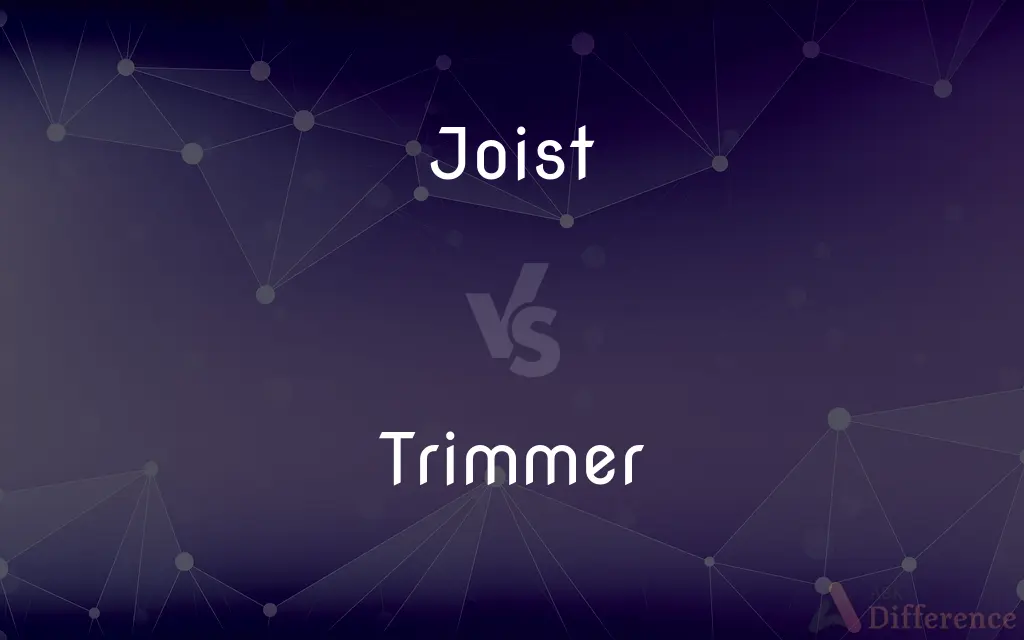Joist vs. Trimmer — What's the Difference?
Edited by Tayyaba Rehman — By Fiza Rafique — Updated on April 20, 2024
Joists are horizontal structural members used in framing to support a floor or ceiling, while trimmers are specialized joists that frame openings like doors or stairs.

Difference Between Joist and Trimmer
Table of Contents
ADVERTISEMENT
Key Differences
Joists are integral components of building construction, providing support across open spaces for floors, ceilings, and roofs. These beams typically run parallel to one another at regular intervals. Trimmers, on the other hand, serve a more specific function; they are joists that support the edges of openings in floors or walls, such as for staircases or fireplaces.
While joists are generally uniform in spacing and length within a specific area to distribute load evenly, trimmers are installed adjacent to openings and often have to carry additional load. This may require them to be doubled or reinforced, depending on the size of the opening they surround.
Joists are typically sized according to the load they must support and the span they must cover, following building codes and standards. Trimmers, while also adhering to these requirements, must often be customized or enhanced due to the extra stresses placed on them by the openings they frame.
In residential construction, joists can be made from a variety of materials, including wood, steel, or engineered wood products. Trimmers, by necessity, are made from similar materials but might require additional features like joist hangers or other forms of structural support to ensure stability and safety.
Joists form a part of the basic skeleton of a floor or ceiling framework, and their installation is one of the early steps in framing a structure. In contrast, trimmers are installed as part of more detailed framing work that involves creating openings in floors and walls, which usually occurs after the basic framing is in place.
ADVERTISEMENT
Comparison Chart
Definition
Horizontal structural members in building framing.
Joists that frame openings in structures.
Function
Support floors, ceilings, roofs.
Support around openings like doors, stairs.
Placement
Uniformly spaced across areas.
Adjacent to specific openings.
Load Characteristics
Evenly distributed load.
Additional load from openings.
Material & Support
Wood, steel, engineered wood.
Similar materials, often requires more support features like joist hangers.
Compare with Definitions
Joist
A long, rigid, horizontal structural element used in construction to support floors and ceilings.
The carpenter measured the spacing between the joists to ensure they were evenly distributed.
Trimmer
Integral in the construction of openings for doors, windows, and stairs.
The builder adjusted the trimmers to ensure the doorway would be perfectly square.
Joist
Can be designed as part of a joist floor system in various construction types.
The architect specified engineered wood joists for the new residential project.
Trimmer
Requires specific placement and often reinforcement to handle additional loads.
Extra trimmers were added around the fireplace opening to support the heavy stone mantle.
Joist
Typically made from timber or steel, it forms part of the framework of a building.
Steel joists are preferred in commercial buildings for their durability and strength.
Trimmer
Can be doubled or paired with headers for larger openings.
Double trimmers were necessary for the wide archway in the entrance hall.
Joist
Often hidden within the ceiling or floor structure but crucial for structural integrity.
The renovation plans included reinforcing the existing joists to support the new upper floor.
Trimmer
Also known as "trimmer joists" in the context of floor and ceiling framing.
The floor plan called for several trimmer joists around the planned elevator shaft.
Joist
A member that spans horizontally between beams to support a load.
We added extra joists to reduce the span and increase the floor's strength.
Trimmer
A joist used to support the edges of an opening in a floor or roof.
The trimmers were installed to frame the new staircase leading to the basement.
Joist
A joist is a horizontal structural member used in framing to span an open space, often between beams that subsequently transfer loads to vertical members. When incorporated into a floor framing system, joists serve to provide stiffness to the subfloor sheathing, allowing it to function as a horizontal diaphragm.
Trimmer
One that trims
A window trimmer.
Joist
Any of the wood, steel, or concrete beams set parallel from wall to wall or across or abutting girders to support a floor or ceiling.
Trimmer
A device or machine, such as a lumber trimmer, that is used for trimming.
Joist
To construct with joists.
Trimmer
One who changes one's opinions, especially in politics, to suit the needs of the moment.
Joist
A piece of timber or steel laid horizontally, or nearly so, to which the planks of the floor, or the laths or furring strips of a ceiling, are nailed.
Trimmer
(Electronics) A variable component used to make fine adjustments to capacity or resistance.
Joist
(transitive) To fit or furnish with joists.
Trimmer
(Architecture) A beam across an opening, such as a hearth, into which the ends of joists can be fitted.
Joist
To fit or furnish with joists.
Trimmer
One who trims, arranges, fits, or ornaments.
Joist
Beam used to support floors or roofs
Trimmer
A device used to trim.
My new electric shaver has a beard trimmer attachment.
Trimmer
(nautical) A member of the crew who trims the sails.
Trimmer
Someone who fluctuates between opposing factions, political parties etc., according to current interest, a flip-flopper.
Trimmer
(architecture) A beam into which are framed the ends of headers in floor framing, as when a hole is to be left for stairs, or to avoid bringing joists near chimneys.
Trimmer
A person employed to rearrange the coal in the hold of a vessel, so that it fills the vessel without forming a conical blockage.
Trimmer
A device for storing coal in gradually increasing piles made by building up at the point of the cone or top of the prism.
Trimmer
(fishing) A float bearing a baited hook and line, used in fishing for pike.
Trimmer
(electronics) An adjustable electrical component. Trimmer (electronics)
Trimmer
(dated) One who or that which trims, or rebukes or reproves; a scold.
Trimmer
One who trims, arranges, fits, or ornaments.
Trimmer
One who does not adopt extreme opinions in politics, or the like; one who fluctuates between parties, so as to appear to favor each; a timeserver.
Thus Halifax was a trimmer on principle.
Trimmer
An instrument with which trimming is done.
Trimmer
A beam, into which are framed the ends of headers in floor framing, as when a hole is to be left for stairs, or to avoid bringing joists near chimneys, and the like. See Illust. of Header.
Trimmer
An apparatus used for piling the coal in gradually increasing piles made by building up at the point of the cone or top of the prism.
Trimmer
A worker who thins out and trims trees and shrubs;
Untouched by the pruner's axe
Trimmer
A machine that trims timber
Trimmer
Capacitor having variable capacitance; used for making fine adjustments
Trimmer
Joist that receives the end of a header in floor or roof framing in order to leave an opening for a staircase or chimney etc.
Common Curiosities
Why are trimmers sometimes doubled in construction?
Doubling trimmers helps to distribute the additional load caused by openings in floors and walls, enhancing structural integrity.
What is a joist in construction?
A joist is a horizontal structural element used in framing to support a floor, ceiling, or roof.
Can joists be used for both floors and ceilings?
Yes, joists are versatile structural elements that can be used in both floor and ceiling applications to provide support across open spaces.
How are joists different from beams?
Joists are typically smaller than beams and are used to support loads over shorter spans within floors and ceilings, whereas beams support larger loads over longer spans.
How do you size a joist for construction?
Joists are sized based on the load they need to support and the span they must cover, according to building codes and engineering principles.
What does a trimmer do in framing?
A trimmer is a specialized joist that supports the edges of openings such as doors, windows, or staircases in a building structure.
Can engineered wood be used for trimmers?
Yes, engineered wood is suitable for trimmers as well as regular joists, offering high strength and resistance to warping.
What materials are commonly used for making joists?
Common materials for joists include wood, steel, and engineered wood products.
Are there any special considerations for joists in areas prone to earthquakes?
In earthquake-prone areas, joists may require additional bracing or anchoring to prevent shifting during seismic events.
What are the safety concerns when working with joists and trimmers?
Safety concerns include ensuring proper support during installation to prevent collapses and using personal protective equipment to avoid injuries.
Are trimmers necessary for every opening in a structure?
Yes, trimmers are necessary around openings to ensure that the structure remains stable and the load around the opening is properly supported.
How does the installation of trimmers differ from that of regular joists?
Trimmers require specific placement and additional support measures, such as joist hangers or double joisting, due to their role in framing openings.
What is the typical spacing between joists in a residential building?
The typical spacing can vary, but it is often 16 to 24 inches on center, depending on the load requirements and floor materials.
What are some common tools needed for installing joists?
Common tools include hammers, tape measures, and levels.
Do trimmers affect the overall aesthetics of a building?
Trimmers are usually internal elements and do not affect the exterior aesthetics, but they are crucial for the proper alignment and functionality of openings within the structure.
Share Your Discovery

Previous Comparison
Brown vs. Beige
Next Comparison
Nature vs. TypeAuthor Spotlight
Written by
Fiza RafiqueFiza Rafique is a skilled content writer at AskDifference.com, where she meticulously refines and enhances written pieces. Drawing from her vast editorial expertise, Fiza ensures clarity, accuracy, and precision in every article. Passionate about language, she continually seeks to elevate the quality of content for readers worldwide.
Edited by
Tayyaba RehmanTayyaba Rehman is a distinguished writer, currently serving as a primary contributor to askdifference.com. As a researcher in semantics and etymology, Tayyaba's passion for the complexity of languages and their distinctions has found a perfect home on the platform. Tayyaba delves into the intricacies of language, distinguishing between commonly confused words and phrases, thereby providing clarity for readers worldwide.














































